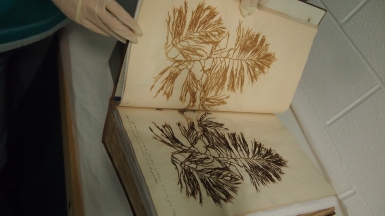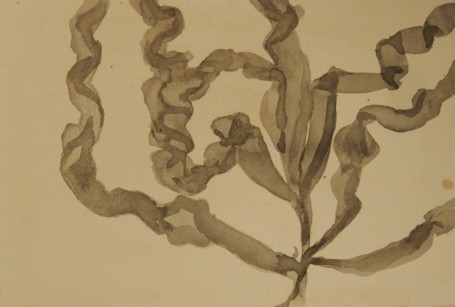Having seen a display of Victorian seaweed albums by Devon based collector, Mary Wyatt at The Royal Albert Memorial Museum (RAMM) in Exeter, I discovered that they have a considerable seaweed herbarium and thought it was time that I went to take a look. I arranged this with the Collections Officer, Holly Morgenroth and visited on 13th March.
Intriguingly the archive is located in a building called The Ark, in reality a pretty bland building on an industrial estate outside Exeter. It was hard to know what to request to see, partly as they have a large collection of seaweed albums and herbarium sheets, also because other than the collections of Amelia Griffiths and Mary Wyatt who worked together in Torquay – I didn’t know exactly what collections they held. Holly met me and had taken out quite a large number of the albums and boxes of herbarium sheets. I had imagined that I might be able to leaf through the albums myself, but as they are very fragile I was not able to handle them. There is a definite sense of mystery, wonder, preciousness/ inaccessibility in the archive, and a feeling of privilege if you are given access. The rituals, protocols and specialised equipment associated with archives all creates a particular, rarified atmosphere. Hans Ulrich Obrist mentions the impact this had on him as a child with reference to a library: My child’s mind was very deeply attracted to and marvelled at this library… the white gloves worn by its staff, the readers forced to walk silently wearing felt slippers.’ I took these behind the scene photos at the RAMM archive, intrigued by the stacks of archival boxes.
On seeing the volume of material Holly had laid out for me, Arlette Farge’s comments in The Allure of the Archive which I have read recently came to mind-
‘When working in the archive you will often find yourself thinking of this exploration as a dive, a submersion, perhaps even a drowning… you feel immersed in something vast, oceanic.’ Farge, Arlette (2015) The allure of the archives. New Haven: Yale University Press. p.4
I took notes from my discussion with Holly which revealed that there are a lot of gaps in their knowledge about the collections and the identities of the collectors, she occasionally has time to do some detective work, share knowledge with other museum curators and fill in the gaps.
 A couple of things which struck me – the beauty of the pressed specimen and the contradiction between the delicacy of the specimen and their longevity – maintaining much of their brightness partly because of their conservation and lack of exposure to light. As with my family seaweed album, the albums often had very clear mirrored imprints created by the seaweed which look like rust. I photographed a selection of the work which instinctively appealed in terms of colour or form and I thought I could work from. Here is a selection of the photos:
A couple of things which struck me – the beauty of the pressed specimen and the contradiction between the delicacy of the specimen and their longevity – maintaining much of their brightness partly because of their conservation and lack of exposure to light. As with my family seaweed album, the albums often had very clear mirrored imprints created by the seaweed which look like rust. I photographed a selection of the work which instinctively appealed in terms of colour or form and I thought I could work from. Here is a selection of the photos:
The collections range from amateur collectors and decorative albums – see cross stitched album cover above to scientific collections such as Griffiths’ Algae Danmoniensis. The majority of the collections are by women, some were jointly collected by husband and wife collectors. Apparently a significant number of serious collectors were vicars and their wives, as you can see with the cross stitched cover, the observation of nature including seaweed was seen as a way of being close to god and his mysteries.
Following my visit I have created a number of ink drawings based on the photographs – some of these are drawn over backgrounds which are monoprinted with my seaweed inks.













